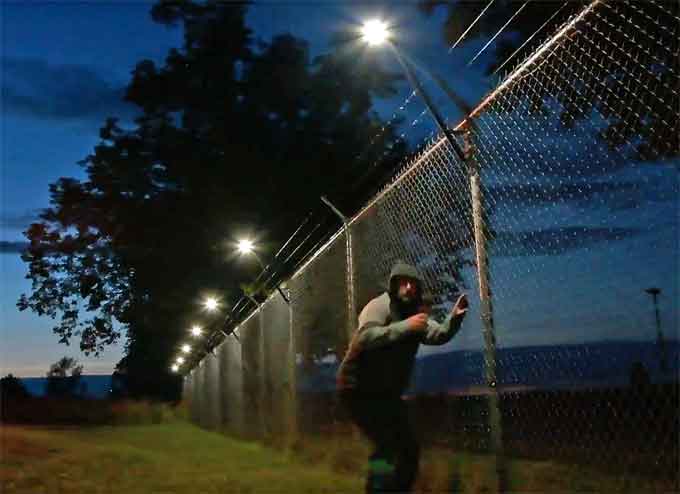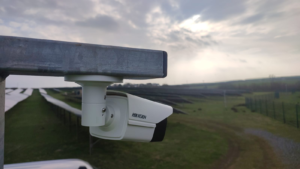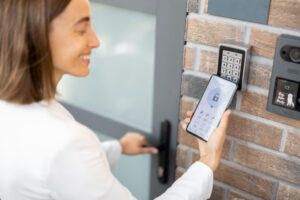Perimeter security is the process of securing the boundaries of a property or an area from unauthorized access or intrusion. It is a crucial component of any security system, as it prevents, detects, and delays potential threats before they can reach the inner premises. Perimeter security can also enhance the aesthetic appeal and value of a property, as well as provide privacy and safety for the occupants.
There are different types of perimeter security solutions available, depending on the level of protection, the size and shape of the area, the budget, and the preferences of the owner. In this article, we will explore the different types and benefits of perimeter security, and how Pulsar Vertex can help you implement the best solution for your needs.
Table of Contents
ToggleWhat is perimeter security?
Perimeter security refers to natural barriers or built fortifications to either keep intruders out or to keep captives contained within the area the boundary surrounds.
Perimeter security covers systems that are designed to protect a site’s perimeter from a range of security threats, such as:
- Theft
- Vandalism
- Sabotage
- Terrorism
- Espionage
- Trespassing
- Kidnapping
- Assault
Perimeter security is essential for sites with significant assets to protect, such as:
- Solar farms
- Construction sites
- Car dealerships
- Large schools
- Warehouses
- Distribution and logistics centres
- Industrial sites
These types of businesses will typically have millions of pounds in revenue to protect, in addition to:
- Plant machinery
- Goods
- Stock
- Forklift trucks
- Solar panels
- IT hardware
- Cash
What are the different types of perimeter security?
The different types of perimeter security solutions include:
- Perimeter protection systems
- Perimeter CCTV surveillance and offsite monitoring
- Perimeter detection systems
- Access control systems

Perimeter protection systems
Perimeter protection systems are the simplest and most cost-effective form of perimeter security. They create a physical barrier that prevents or slows down intruders from entering or leaving the area. Perimeter protection systems include:
- Fencing
- Gates
- Bollards
- Barriers
Fencing is the most common type of perimeter protection system. It can be made of various materials, such as metal, wood, plastic, or wire, and can have different designs, such as chain-link, palisade, mesh, or picket. Fencing can also be combined with other security features, such as razor wire, spikes, or electric currents, to increase the deterrence and detection capabilities.
Gates are the entry and exit points of a perimeter security system. They control the access of vehicles and pedestrians to and from the area. Gates can be manual or automatic, and can have different mechanisms, such as swing, sliding, or bi-folding. Gates can also be integrated with other security devices, such as locks, cameras, intercoms, or card readers, to verify the identity and authorization of the visitors.
Bollards are short, sturdy posts that are installed in the ground to block or restrict the movement of vehicles. They are usually made of steel, concrete, or plastic, and can have different shapes, such as cylindrical, square, or spherical. Bollards can be fixed, removable, or retractable, depending on the flexibility and frequency of access required. Bollards can also be illuminated, reflective, or decorative, to enhance the visibility and appearance of the area.
Barriers are devices that are used to raise or lower a horizontal or vertical obstacle to control the access of vehicles or pedestrians. They are usually made of metal, wood, or plastic, and can have different forms, such as boom, drop arm, wedge, or turnstile. Barriers can be operated manually or automatically, and can be synchronized with other security systems, such as sensors, alarms, or lights, to indicate the status and alert the authorities in case of a breach.
Perimeter protection systems also cover physical security, such as guards and keyholders, who can patrol the area, respond to alarms, and confront intruders.

Perimeter CCTV surveillance and offsite monitoring
Perimeter CCTV surveillance is an advanced form of perimeter security. It uses cameras to monitor and record the activities and events in a specific area. It is an effective way of detecting and identifying intruders, as well as providing evidence and information for investigation and prosecution. Perimeter CCTV surveillance can also deter potential threats, as they know they are being watched and recorded.
Perimeter CCTV surveillance can be installed in strategic locations, such as gates, fences, or walls, and can have different features, such as night vision, zoom, or motion detection, to enhance the quality and coverage of the surveillance.
Perimeter CCTV surveillance can be viewed internally by an onsite security team, or offsite via the use of CCTV monitoring.
CCTV monitoring is where a business’s CCTV system and cameras are monitored offsite by a team of security professionals. When the system is triggered, an alert is sent to an offsite security team (ARC) for them to take the appropriate action.
Sites with a vast perimeter often need protecting most at night. To aid detection accuracy, the range of cameras we recommend are:
- PTZ cameras
- IP CCTV cameras
- Thermal CCTV and video analytics
- ANPR CCTV cameras
ANPR CCTV cameras are cameras that can recognise and record number plates of vehicles. They can be used to track, monitor, and verify the vehicles that enter or exit the area, as well as to enforce parking rules, tolls, or speed limits.
Perimeter detection systems
Perimeter detection systems are sophisticated systems that can sense the presence or movement of intruders near or across the perimeter. They can trigger an alarm, a notification, or a response when they detect an intrusion. Perimeter detection systems include:
- Passive infra-red (PIR) sensors
- Infra-red (IR) lighting and illuminators
- Perimeter intrusion detection systems (PIDS)
PIR sensors are devices that detect the infrared radiation emitted by humans or animals. They can be installed on fences, walls, or poles, and can cover a wide area. When they sense a change in the infrared radiation, they can activate an alarm, a camera, or a light.
IR lighting and illuminators are devices that emit infrared light that is invisible to the human eye, but visible to cameras. They can be used to illuminate dark or shadowed areas, and to enhance the performance of CCTV cameras. They can also be used to create an invisible beam that can trigger an alarm when broken.
PIDS are systems that use various technologies, such as microwave, radar, fibre optic, or acoustic, to detect vibrations, disturbances, or intrusions along the perimeter. They can be buried, attached, or mounted on the perimeter, and can provide accurate and reliable detection.

Access control systems
Access control systems are systems that regulate and restrict the access of people or vehicles to a property or an area. They can be used to grant or deny access based on various criteria, such as identity, authorization, time, or location. Access control systems include:
- Locks and keys
- Keypads and codes
- Cards and readers
- Biometrics and scanners
- Mobile and cloud
Locks and keys are the most basic form of access control. They can be mechanical or electronic, and can be opened or closed with a physical key or a remote control.
Keypads and codes are devices that require a user to enter a numerical or alphanumeric code to gain access. They can be standalone or integrated with other systems, such as intercoms or cameras.
Cards and readers are devices that use magnetic, barcode, or smart cards to store and verify the user’s information. They can be swiped, inserted, or tapped on a reader to grant or deny access.
Biometrics and scanners are devices that use the user’s unique physical or behavioural characteristics, such as fingerprints, iris, voice, or face, to authenticate and authorise the user. They can provide a high level of security and convenience, as they eliminate the need for keys, cards, or codes.
Mobile and cloud are devices that use smartphones, tablets, or computers to access and manage the access control system. They can use wireless, Bluetooth, or internet technologies to communicate with the system, and can offer remote and flexible access.

What are the benefits of perimeter security?
Perimeter security offers many benefits for businesses and organisations, such as:
- Protecting the property and assets from theft, vandalism, or sabotage
- Protecting the people and animals from harm, injury, or attack
- Preventing unauthorized access or trespassing
- Reducing the risk of liability or litigation
- Increasing the sense of security and peace of mind
- Improving the aesthetic appeal and value of the property
Perimeter security is an essential component of any security system, as it provides the first line of defense and prevention against external threats.
In Pulsar Vertex, we are experts in High security perimeter detection systems .

